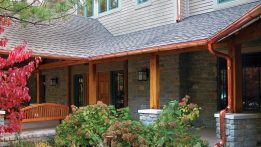 A fire burning in your fireplace is a good way to keep warm during winter months, and there’s nothing more enjoyable than gathering around the fire on a cold night. Whether wood or gas burning, in order to keep your fireplace in working order, it’s important to keep up proper maintenance. Proper maintenance of your fireplace can protect you and your family from hazardous gases, materials and fires. To make sure your fireplace provides safe comfort for you and your family for years to come, you should have your fireplace inspected and cleaned by a qualified professional once a year, but there are also a few things you can do to maintain your fireplace.
A fire burning in your fireplace is a good way to keep warm during winter months, and there’s nothing more enjoyable than gathering around the fire on a cold night. Whether wood or gas burning, in order to keep your fireplace in working order, it’s important to keep up proper maintenance. Proper maintenance of your fireplace can protect you and your family from hazardous gases, materials and fires. To make sure your fireplace provides safe comfort for you and your family for years to come, you should have your fireplace inspected and cleaned by a qualified professional once a year, but there are also a few things you can do to maintain your fireplace.
Inspect the Chimney
 Before you start your first fire of the season, inspect the foundation of your chimney. Cracks, missing mortar, and loose bricks can all be signs of chimney deterioration. If you notice any damage, it is best to contact a professional to make repairs to the masonry work. As part of your chimney inspection, be sure to check inside the chimney. Make sure there isn’t anything inside your chimney that can obstruct the escape of smoke, such as birds’ or squirrels’ nests, leaves, or dead animals. Installing a cap over your chimney can help prevent these obstructions. Also, be sure to check the damper, a plate that sits before the flue of your chimney. The damper helps control ventilation. It helps to keep the cold air out when you’re not using your fireplace, allows the smoke to escape through the flue when your fireplace is being used, and helps to control how long and well your fire burns. If your damper is not opening or closing the way it should, this could lead to smoke filling your home and cold drafts that could drive your energy bill up. A reason your damper may not be working correctly is a buildup of creosote or debris. Removing the debris and cleaning the flue should resolve this problem, and a professional chimney sweep can do this for you.
Before you start your first fire of the season, inspect the foundation of your chimney. Cracks, missing mortar, and loose bricks can all be signs of chimney deterioration. If you notice any damage, it is best to contact a professional to make repairs to the masonry work. As part of your chimney inspection, be sure to check inside the chimney. Make sure there isn’t anything inside your chimney that can obstruct the escape of smoke, such as birds’ or squirrels’ nests, leaves, or dead animals. Installing a cap over your chimney can help prevent these obstructions. Also, be sure to check the damper, a plate that sits before the flue of your chimney. The damper helps control ventilation. It helps to keep the cold air out when you’re not using your fireplace, allows the smoke to escape through the flue when your fireplace is being used, and helps to control how long and well your fire burns. If your damper is not opening or closing the way it should, this could lead to smoke filling your home and cold drafts that could drive your energy bill up. A reason your damper may not be working correctly is a buildup of creosote or debris. Removing the debris and cleaning the flue should resolve this problem, and a professional chimney sweep can do this for you.
Clean the Interior
 When maintaining your fireplace, it’s important to keep the firebox clean. When cleaning a gas-burning fireplace, clean the louvers of dust and dirt with a microfiber towel. If your fireplace doesn’t have louvers, check the air cavities to be sure they are clear of any obstructions, dirt or dust buildup. When cleaning your wood-burning firebox, place newspaper or a tarp on your hearth to catch any falling ash. Using your fireplace shovel, scoop the ash from the bottom of the firebox and sweep up any excess ash with a small broom and dustpan. Burning wood produces a flammable carbon substance called creosote. Soot and creosote can build up in your chimney and can cause dangerous chimney fires. Although the interior of your wood-burning firebox can be cleaned with a mixture of water and vinegar and a brush to remove ash and soot buildup, cleaning creosote buildup from your chimney requires a professional, so make sure to look for a local chimney sweep who can provide this service.
When maintaining your fireplace, it’s important to keep the firebox clean. When cleaning a gas-burning fireplace, clean the louvers of dust and dirt with a microfiber towel. If your fireplace doesn’t have louvers, check the air cavities to be sure they are clear of any obstructions, dirt or dust buildup. When cleaning your wood-burning firebox, place newspaper or a tarp on your hearth to catch any falling ash. Using your fireplace shovel, scoop the ash from the bottom of the firebox and sweep up any excess ash with a small broom and dustpan. Burning wood produces a flammable carbon substance called creosote. Soot and creosote can build up in your chimney and can cause dangerous chimney fires. Although the interior of your wood-burning firebox can be cleaned with a mixture of water and vinegar and a brush to remove ash and soot buildup, cleaning creosote buildup from your chimney requires a professional, so make sure to look for a local chimney sweep who can provide this service.
Choosing the Correct Wood
 When trying to find wood to burn in your fireplace, it may seem that any wood would work for your burning needs, but not all woods are the same. When choosing wood, it’s important to pick the right kind. The wood you put in your fireplace should be seasoned wood, meaning it has been dried for 6-12 months. You should also avoid soft woods, such as pine or cedar, and stick with hard woods like maple or oak. Seasoned, hard woods do not produce as much creosote as soft woods and burn hotter and longer.
When trying to find wood to burn in your fireplace, it may seem that any wood would work for your burning needs, but not all woods are the same. When choosing wood, it’s important to pick the right kind. The wood you put in your fireplace should be seasoned wood, meaning it has been dried for 6-12 months. You should also avoid soft woods, such as pine or cedar, and stick with hard woods like maple or oak. Seasoned, hard woods do not produce as much creosote as soft woods and burn hotter and longer.
Check Your Smoke and Carbon Monoxide Alarms
 Making sure your smoke and carbon monoxide alarms are in working order are an often forgotten but pertinent part of fireplace maintenance. A buildup of dirt and debris can lead to a clogged chimney or vent. If the chimney is not exhausting smoke and gases like it should, this can lead to smoke inhalation and carbon monoxide poisoning. Because carbon monoxide has no odor or color, it can go undetected by you or your family. To ensure the safety of everyone in your home, check the functionality of your smoke alarms, and, if necessary, install carbon monoxide detectors.
Making sure your smoke and carbon monoxide alarms are in working order are an often forgotten but pertinent part of fireplace maintenance. A buildup of dirt and debris can lead to a clogged chimney or vent. If the chimney is not exhausting smoke and gases like it should, this can lead to smoke inhalation and carbon monoxide poisoning. Because carbon monoxide has no odor or color, it can go undetected by you or your family. To ensure the safety of everyone in your home, check the functionality of your smoke alarms, and, if necessary, install carbon monoxide detectors.
To enjoy your fireplace for many more years, it’s essential to keep up with its maintenance. Make sure you inspect your chimney for any cracks or missing mortar and keep your firebox clean and free of too much ash. When it’s time to use your fireplace, be sure to choose the correct wood and update or install smoke and carbon monoxide alarms. Most importantly, be sure to hire a qualified chimney sweep to inspect and clean your fireplace and chimney to protect the health and well-being of your family. ![]()
Aliyah Robinson
Home & Yard Magazine




